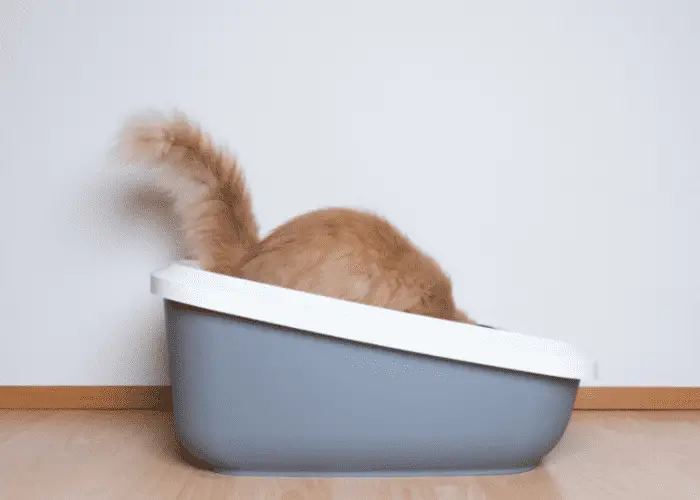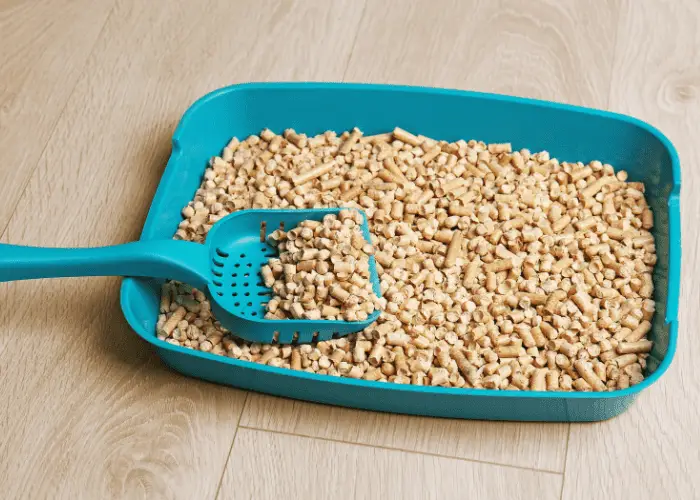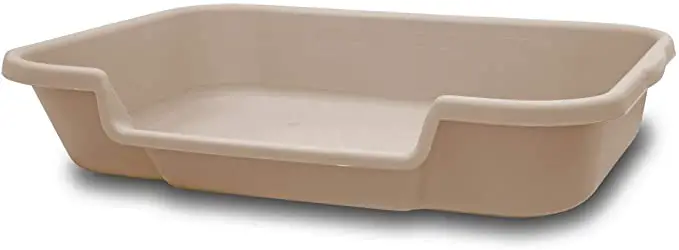This article contains affiliate links, and we may earn a commission at no cost to you if you choose to purchase through these links. I never recommend products that I do not trust or will not advise my veterinary clients and patients to use.
Munchkins’ short legs make it rather difficult for them to get in and out of litter boxes with the same ease that longer-legged cats can. Luckily, there are quite a few possible solutions to this problem.
The best litter box for Munchkin cats is a senior cat litter box with a low front and high sides. Alternatively, conventional litter boxes can be modified to have a small ramp or step. Older Munchkins and Munchkin kittens need litter boxes with shallow sides.
This article will provide you with all the information you need regarding the types of litter boxes that you can use, the pros and cons of each, and a few general litter box tips.

Litter Box Considerations For Munchkins
Ease Of Access
This is the most critical Munchkin-specific consideration. Their shorter leg length puts them at a disadvantage when using a litter box designed for ‘regular’ cats.
The International Feline Federation (FiFe) does not accept the Munchkin as an official breed, and therefore there are no official breed standards. However, the following categories of front leg length have been accepted by Munchkin breeders:
- Standard: leg length of 3-4 inches
- Super Short: leg lenlitterboxesinches
- Rug Hugger: leg length less than 2 inches
Of course, rug huggers will definitely need modified litter boxes, but most adult Munchkins with standard leg length will be able to use regular litter boxes.
You can read more about how leg length differs between Munchkins and how it affects their jumping ability in this article.
Older Munchkins and Munchkin kittens will also have a reduced ability to climb over the high sides of conventional litter boxes.
Size
Guy et al. (2014) found that most cats prefer larger litter boxes. Even larger than most commercially available litter boxes. The cats in the study preferred the larger 34-inch (86 cm) litter box over the standard 24-inch (60 cm).
It would be best if you aimed to get the largest litter box you can accommodate but avoid getting a litter box smaller than 16 inches for an adult cat.
Safe Location
A little box should be in a quiet and safe location. For example, avoid placing it in a high traffic area or somewhere a cat may be bothered by children or other animals while trying to use the litter box.
Substrate
Most cats prefer unscented clumping litter (the exception to this is kittens who should not be offered clumping litter as kittens younger than seven weeks may try to eat litter.
The litter should also be deep enough for them to cover their business, and the litter should not be uLitterboxble to walk on (have sharp or rough edges).



Cleanliness
Ellis et al. (2017) found that odor did not necessarily negatively impact cat litter box usage but rather the physical presence of urine and feces (even fake ones). This shows that cats prefer a litter box with no physical ‘obstructions’ and prefer using a litter box that contains nothing but litter.
This emphasizes the regular removal of urine and feces from a litter box. Litter boxes should be scooped AT LEAST twice daily. And clumping litter makes this task much more manageable.
Multi-Cat Litter Boxes
As a general rule, the number of litterboxes in a multi-cat household should be the number of cats plus one. This will prevent bullying or dominant behavior.
A cat that cannot freely use the litter box due to bullying by other cats/pets/children will be prone to developing stress-related bladder issues.
Individual Preference
A study by Grigg et al. (2012) found that cats generally did not show a strong preference for covered or uncovered little boxes; however, specific individuals in the group did show a strong preference for either litter box style.
This emphasizes the notion that cats should initially be offered a litterbox cafeteria with different styles of litter boxes and various types of substrates to determine which type of litter in litter box your cat prefers.
If your cat suddenly stops using the litter box, you should always have them promptly examined by a vet as many serious health conditions can cause inappropriate elimination in cats.
The 5 Best Litter Boxes For Munchkins
1. Senior Cat Litter Tray
Senior cat litter trays such as the Kitty Go Here Senior or Shirley K’s Senior Cat Litter Box have a low front section and higher sides. The low front was designed for senior cats that may have difficulty climbing over the high sides of conventional litter boxes.

Pros
- Lower front for easy entrance
- Large enough for most cats
Cons
- Litter will easily spill over the front edge
- Often more expensive than conventional litter boxes
The number one recommended litter box for Munchkins is the Shirley K’s Senior Litter Box in extra large. It has a low enough front for easy entrance, high sides to prevent litter spilage and is large enough to accommodate most cats preferences.
2. Soft Side Litter Tray
Munchkins will have an easier time climbing in and out of litter trays with a soft side, such as a travel litter pan or a disposable litter box.
Pros
- The sides of disposable litter boxes can be modified using scissors to be low enough for your Munchkin to enter with ease
- Softer sides will prevent discomfort when climbing in and out of the litter tray
- Great to have available as a backup if a regular litter tray can not be used for whatever reason
Cons
- Will easily get soiled and is not as easy to clean as plastic litter trays (travel litter trays)
- Disposable litter trays will have to be thrown away or composted if soiled
3. Low Side Plastic Tray
An excellent example of a low-side plastic tray is this 10.8-inch plastic trays or any art tray or large flat plastic container.
Pros
- Very affordable
- Multiple trays to place in different spots around the home
- Great for Munchkin kittens
- Only a small amount of litter needed to fill – this makes it more economical when using non-clumping litter where the all the litter should be thrown out when cleaning the tray
Cons
- Too small for adult Munchkins
- Litter spillage over the shallow edge is very likely
- It will be too shallow for cats to cover their droppings properly
4. Ferret and Rabbit Litter Trays
Rabbit and Ferret litter trays such as the Marshall Ferret Litter Pan have low fronts and high sides, similar to a senior cat litter box, but tend to be slightly smaller in size and, therefore, often a bit cheaper well.
Pros
- Low front for easy entry and high sides to minimize litter spilling
- Cheaper than most senior cat litter boxes but similar in design
Cons
- Smaller than conventional cat litter boxes, and some adult cats may find it to be too small for their preference
- Litter will easily spill out the front
5. Litter Tray With Steps or a Ramp
A litter tray with a step entrance or ramp will make it easier for our short-legged Munchkins to enter. An example of such a litter tray is the Nature’s Miracle Automatic Self-Cleaning litter box. The ramp is excellent; however, this particular litter box did not seem to work as it should, so avoid buying it if you are looking for an automatic self-cleaning litter box.
Another option is to buy a separate litter tray ramp such as the Whisker Litter Robot Ramp. Just be sure to double-check the height of your current litter box to check whether this ramp will work.
Alternatively, just construct a small litter box ramp using scrap wood – it will be way cheaper anyway!
Pros
- The ramp or steps makes it easy for Munchkins to access the litter box
- A rough rubber surface on the steps or ramps will help prevent litter trails around the sandbox
Cons
- Often more expensive than conventional litter boxes
- Exiting the litter box will not be as easy as entering the litter box
Conclusion
Munchkins should ideally have a litter tray with a low front entryway and higher sides. The litter box should be larger than 16 inches and be placed where you Munchkin can use it without being disturbed or feeling threatened.
If your cat suddenly stops using the litter box, you should always take them to the vet to rule out bladder-related health conditions.
References
- Ellis, J., McGowan, R. and Martin, F., 2017. Does previous use affect litter box appeal in multi-cat households?. Behavioural Processes, [online] 141, pp.284-290. Available at: <https://www.sciencedirect.com/science/article/pii/S0376635716302972>.
- Grigg, E., Pick, L. and Nibblett, B., 2012. Litter box preference in domestic cats: covered versus uncovered. Journal of Feline Medicine and Surgery, [online] 15(4), pp.280-284. Available at: <https://www.sciencedirect.com/science/article/abs/pii/S1558787814000033>.
- Jezyk, P., 1985. Constitutional Disorders of the Skeleton in Dogs and Cats. In: C. Newton and M. Nunamaker, ed., Textbook of Small Animal Orthopaedics, 1st ed. [online] New York: International Veterinary Information Service. Available at: <http://citeseerx.ist.psu.edu/viewdoc/download?doi=10.1.1.463.1310&rep=rep1&type=pdf>
- L.A. Lyons, D.B. Fox, K.L. Chesney, L.G. Britt, R.M. Buckley, J.R. Coates, B. Gandolfi, R.A. Grahn, M.J. Hamilton, J.R. Middleton, S.T. Sellers, N.A. Villani, S. Pfleuger, Localization of a feline autosomal dominant dwarfism locus: a novel model of chondrodysplasia, the 99 Lives Consortium, bioRxiv 687210; Available at: <https://doi.org/10.1101/687210>
- McGowan, R., Ellis, J., Bensky, M. and Martin, F., 2017. The ins and outs of the litter box: A detailed ethogram of cat elimination behavior in two contrasting environments. Applied Animal Behaviour Science, [online] 194, pp.67-78. Available at: <https://www.sciencedirect.com/science/article/pii/S016815911730151X>.
- Turner, D., Bateson, P. and Gordon, P., 2013. The Domestic Cat: The Biology of its Behaviour. Cambridge University Press.

